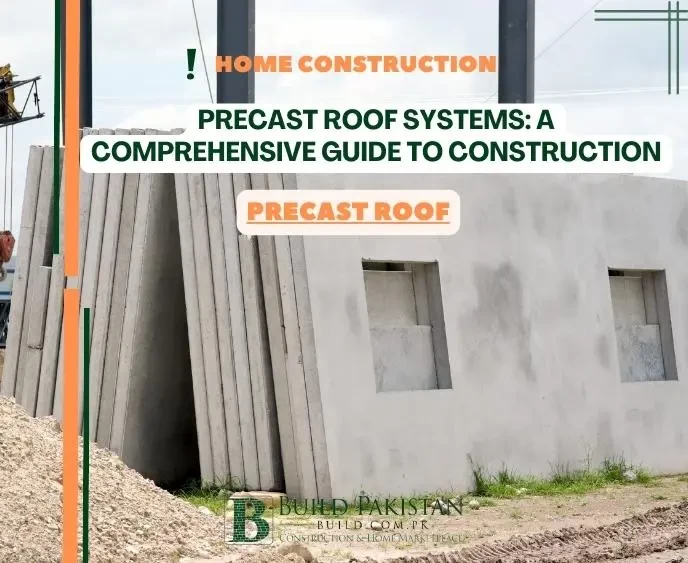Precast Roof Systems: A Comprehensive Guide to Construction

Introduction:
In the realm of contemporary construction, precast roof
systems have emerged as a revolutionary solution, redefining the way roofs are
designed and built. This comprehensive guide navigates through the intricacies
of precast roof technology, exploring its benefits, applications, construction
process, design considerations, and the impact it has on the efficiency and
sustainability of modern buildings.
Understanding Precast Roof Systems:
Precast roof systems represent a departure from traditional
on-site concrete casting. In this method, roof components are cast off-site in
controlled factory conditions, allowing for precision engineering and quality
control. These precast elements, which can include beams, slabs, and other
structural elements, are then transported to the construction site and
assembled into a complete roof system m.

Key Components and Construction Process
Precast Beams and Slabs:
The backbone of a precast roof system consists of beams and
slabs. Precast beams provide structural support, while slabs form the visible
surface of the roof.
Connections:
Precast elements are designed with interlocking features,
ensuring seamless connections on-site. This precision in connection design
contributes to the structural integrity of the roof.
Transportation and Installation:
Once cast and cured, precast components are transported to
the construction site. Installation involves careful lifting and placement of
these elements, forming a cohesive roof structure.
Benefits of Precast Roof Systems
Speed of Construction:
Precast roof systems significantly reduce on-site
construction time. The simultaneous processes of manufacturing off-site while
preparing the foundation on-site contribute to a faster overall construction
timeline.
Quality Control:
Factory-controlled conditions ensure a higher level of
quality control. Precise engineering and standardized production processes
result in consistently high-quality precast elements.
Cost Efficiency:
While the initial costs may include transportation, the
overall cost efficiency of precast roof systems becomes evident when
considering reduced labor requirements, faster construction timelines, and
long-term durability.
Design Flexibility:
Precast technology allows for a high degree of design
flexibility. Architects and engineers can work with a range of shapes,
textures, and finishes to achieve the desired aesthetic while maintaining
structural integrity.
Structural Performance:
Precast roof systems exhibit excellent structural
performance. The load-bearing capacity and resistance to environmental factors
make them suitable for a variety of applications, from residential buildings to
industrial complexes.
Sustainability:
The controlled environment of precast manufacturing reduces
material waste. Additionally, the durability and energy efficiency of precast
elements contribute to the overall sustainability of the construction.
Applications of Precast Roof Systems
Residential Construction:
Precast roof systems find applications in residential
construction, offering a faster and more efficient alternative to traditional
roofing methods.
Commercial and Industrial Buildings:
Large-scale projects, such as warehouses, factories, and
commercial structures, benefit from the speed and reliability of precast roof
systems.
Multi-story Buildings:
Precast technology is well-suited for multi-story buildings,
where the need for structural efficiency and speed of construction is
paramount.
Infrastructure Projects:
Infrastructure projects, including bridges and parking
structures, leverage the benefit s of precast technology for accelerated
construction timelines.
Design Considerations and Customization
Architectural Finishes:
Precast roof systems can be customized with various
architectural finishes, including textured surfaces, patterns, and even
imprints, allowing for a seamless integration with the overall design vision.
Load-Bearing Requirements:
The design of precast elements considers specific
load-bearing requirements. Engineers work closely with architects to ensure
that the precast roof system meets the structural demands of the building.
Insulation and Energy Efficiency:
Considerations for insulation and energy efficiency are
integrated into the design pr ocess. Precast roof systems can be designed to
accommodate insulation materials, contributing to the overall energy
performance of the building.
Conclusion:
In conclusion, precast roof systems represent a paradigm shift in modern construction methodologies. The efficiency, cost-effectiveness, and sustainability of these systems make them a compelling choice for a wide range of applications. As the construction industry continues to evolve, precast technology stands as a testament to the marriage of innovation and practicality, reshaping the way roofs are conceptual ized and constructed in the contemporary built environment. Whether in residential, commercial, or industrial projects, precast roof systems are set to play a pivotal role in the future of construction, offering a blend of efficiency, quality, and sustainability.









